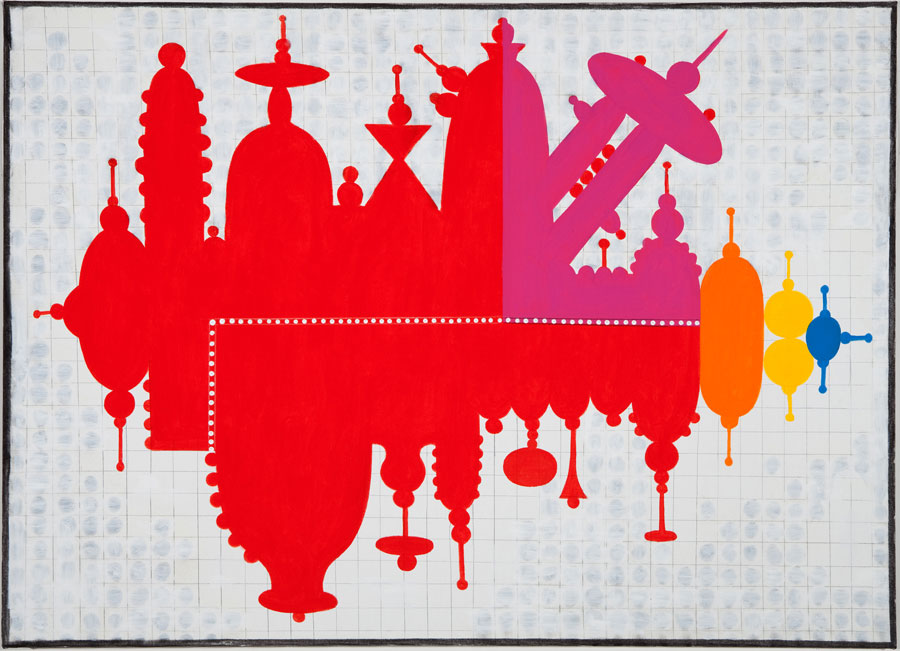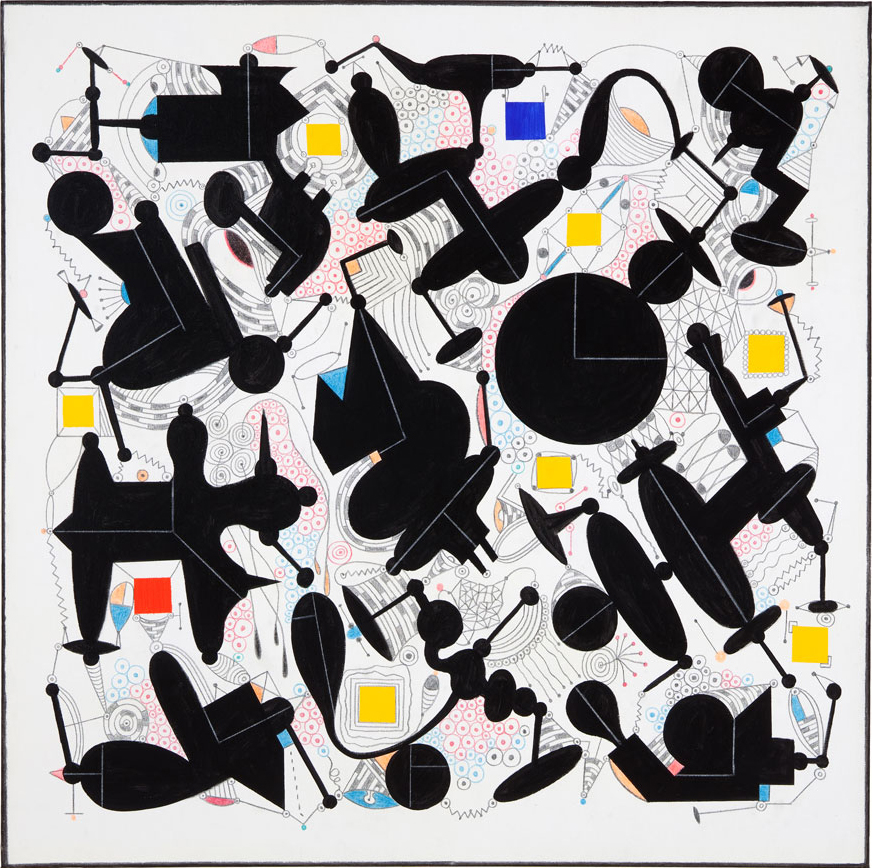By D. Eric Bookhardt, via artpulsemagazine.com
It has been said, most famously by the 17th-century poet John Donne, that “No man is an island.” And while no doubt true in the philosophical sense that Donne intended, human history has largely been defined by the things that isolate and divide us as individuals and communities, not the least of which are the ideological and geographical divisions that confront us in everyday life. In ways both physical and metaphorical, Luis Cruz Azaceta has long been an artist of islands. Born in Havana, Cuba, in 1942, he emigrated to this country in 1960, where he studied at the School of Visual Arts and made a name for himself on another island, Manhattan, as he rose to prominence in the Neo-Expressionist movement of the 1970s and 1980s. He was considered one of America’s leading Hispanic artists by 1992 when he and his wife, Sharon Jacques, moved to New Orleans, another city surrounded by water. There, as before, his work continued his long-standing theme of individuals either literally or figuratively at sea, surrounded by mysterious forces in which mere mortals are often in over their heads. Throughout his long career, his painterly style has evolved from the gestural expressionism of his earlier years to an ever more abstract sensibility, yet the underlying humanistic impulse that propels his work has never wavered.
Be that as it may, his “Shifting States” exhibition at New Orleans’ Arthur Roger Gallery appears to break new ground in ways that may initially seem enigmatic. Blood Line suggests a Rorschach blot studded with the oddly similar forms of mosques, radar antennae, minarets and microwave towers in a bristling nimbus of potential mayhem. Its colorful crimson arabesques appear paradoxical, but pointedly so. We live in a time of epochal clashes, not of so much of civilizations as of cultures struggling to internally assimilate the implications of encompassing social and technological changes even as they attempt to maintain the bedrock belief systems of the past. It is a time when archaic holy men mandate the enrichment of uranium in space-age centrifuges and holy warriors in robes are stalked and exterminated by remote-controlled drones, a conflation of archaic militancy and recent military-industrial technology that leads to a pervasive disequilibrium as socio-cultural centers of gravity are challenged by the tectonic shifts of changing times. Blood Line is both Rorschach and cipher, a portent of peril and promise conjoined in an unstable trajectory.
Employing similarly encoded forms, Surveillance suggests a maze of circuits attached by electronic umbilicals to lethal-looking pods in improbable candy colors. All sprout ominous appendages, and the effect is unsettling, as if people now exist in a maze of invisible connections, silently stalked by our own Smartphones and GPS devices reporting our every move to invisible cybernetic observers, silent sentinels that record our preferences, political views and buying habits in distant data banks linked by satellites to vast electronic migrations of capital encircling the earth like ethereal tidal currents. At the individual level, these new electronic tides encourage people to feel connected even as they swamp them with unknown implications that even the most autocratic rulers ignore only at their own risk. In the geopolitical realm, nation states become like vessels, or floating islands, in turbulent seas of capital where they must stay afloat as best they can or rely on reluctant neighbors for bailouts that may or may not come, and at costs never imagined in more buoyant times.
As traditional ways of life are increasingly washed away by tsunamis of technologically propelled change, individuals and nations may arm themselves against forces that defy their understanding. In Shifting States: Iran, the silhouette of a civilization defined by both ancient and futuristic forms appears on a horizon accompanied by its own simulacrum like a chimera reflected in a mirage, only here neither its friends nor its enemies, nor perhaps its own citizens, has any reliable way of knowing the difference between the appearance and the reality. In Shifting States: Iraq, that nation appears as a heavily armed vessel afloat in a sea of smoke, an ethereal nimbus surrounding a militantly bifurcated form defined by guns and minarets above and dripping oil pipelines below. That sense of militarized technology evolving into a hyper-realized and near-autonomous entity in its own right is effectively conveyed in Scramble. Here forms suggestive of electronically linked weapon systems appear as militaristic constellations in a kind of cybernetic cloud, in a rhythmically pulsating composition like a science-fiction reprise of Mondrian’s iconic modernist opus, Broadway Boogie Woogie.
Such compositions of seemingly floating forms relate to Azaceta’s earlier Neo-Expressionist images of boat people, or more specifically, individuals adrift in leaky vessels that have taken them far from home, even as their destination, their dream of sanctuary, remains a distant hope. If the mysterious forces of new technologies have in some ways mitigated our dependence on nature, it is also true that nature has not been a passive bystander in this process but has become a more powerful adversary as human activity leads to climate change and the concomitant intensification of storms, hurricanes and floods attributable to global warming. Although man-made barriers to rivers and lakes may protect us for a while, nature remains both a benefactor and an implacable adversary. Even the elaborate levee systems along the banks of waterways like the Mississippi River sometimes become inadequate, so emergency measures must be implemented, as we see in Morganza Water Spill, a composition that returns us to the elemental source of Azaceta’s inspiration, the waters that both enable and destroy life as we know it.
The title refers to Louisiana’s Morganza Spillway, a channel with floodgates that, when opened, shunt river water away from large cities and into ancient swamps, where they may rise to turn adjacent towns and villages into islands confronted with varying degrees of inundation, just as the city of New Orleans was itself inundated like a modern Atlantis when hurricane Katrina’s tidal surge pushed the Gulf of Mexico through its surrounding wetlands. All of which returns us to the ancient mythic notion of the sea as a metaphor for all things mysterious, hidden or sequestered, a notion Azaceta has updated to include the unintended consequences of technological innovation. Now, as in times past, individuals and communities are at the mercy of unpredictable protean forces, buffeted about like boats in eternally shifting seas. Or as John Donne put it in the lines following his “no man is an island” metaphor, ask not “for whom the bell tolls, it tolls for thee.” Azaceta suggests that even now, centuries after Donne penned those fateful words, human destiny remains as unpredictable and unresolved as ever.
(January 7 – February 18, 2012)
D. Eric Bookhardt is a New Orleans art critic and journalist. He contributes to ARTnews, Public Art Review, and Gambit Weekly, among other publications. He is currently the editor of Inside Art New Orleans and president of the Center for Gulf South History and Culture.



